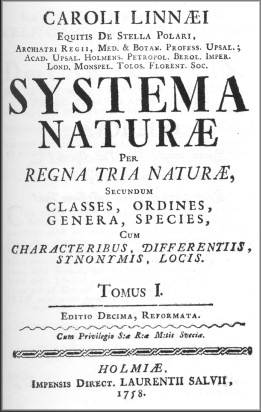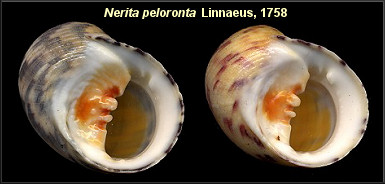|
Linnaeus on Mollusks |
|
|
By Harry G. Lee |
|
|
|
Wednesday, May 23, 2007, marked the 300th anniversary of the birth of Carolus Linnaeus, father of binominal system of taxonomic nomenclature. His innovation, published the day after his 51st birthday (Linnaeus, 1758), revolutionized descriptive biology and continues to be the standard in plant and animal classification. Among the thousands of organisms he named in this magnum opus, written in Latin, are 683 species-level presently considered to be in the Mollusca. These were placed in 39 genera, most of which were in the assortment he called “Vermes Testacea,” but, as shown below, some mollusks were grouped with members of other phyla. Below is an account of these genera along with the species count of for each (placed in parentheses). Non-molluscan groups [placed in square brackets] are included in the format, but not the species counts, to demonstrate the slight imperfections of the hierarchical system conceptualized by the Master. |
|
Insecta Aptera [pp. 608-640] Monoculus [Arthropoda, but on p. 635: M. telemus, a pteropod mollusk is named]* (1 species) Vermes I Intestina [pp. 647-651]
Vermes II Mollusca [pp. 652-666]
Vermes III Testacea [pp. 667-788]
Serpula [mixed Mollusca, Annelida and Foraminifera]* (5 species) * four genera comprised of more than one phylum but including Mollusca. Among the 39 molluscan genera (including the four heterogeneous ones) introduced in the Tenth edition are: one in Class Scaphopoda, one in Polyplacophora, three in Cephalopoda, 14 in Pelecypoda, and 20 in Gastropoda. Although the majority of his molluscan genera are unambiguous, many of the 683 constituent molluscan species-level taxa in this work required the attention of later taxonomists for clarification. An example of that sort of analysis is the work of Henry Dodge (1952-1959; 517 species in bold above; see bibliography), who, like many predecessors, dealt with the fact that the Systema Naturae was not illustrated, that his descriptions were often insufficient, and that he cited earlier iconographies in which the figures not always artistically accurate. A particularly frustrating problem with the use of these indications was that under a single Linnaean species there were usually multiple references to illustrations, the figures in which depicted shells belonging to various species or even genera. In those early days of conchology, this imprecision was inevitable. Ultimately, through hard work and the machinations of formal taxonomy and nomenclature (his own innovations!), a large majority of the species names introduced by Linnaeus in 1758 became unambiguously identifiable. Only a few are considered synonyms or unidentifiable (nomina dubia) today. A companion document shows a modern-day analysis of two of his molluscan genera, Conus and Cypraea. Aside from the many species of mollusks he defined, Carolus Linnaeus has provided conchology a legacy which underpins virtually all aspects of an understanding of these organisms. Dodge, H., 1952. A historical review of the mollusks of Linnaeus. Part I. The classes Loricata and Pelecypoda. Bull. Amer. Mus. Nat. Hist. 100(1): 1-263. Dodge, H., 1953. A historical review of the mollusks of Linnaeus. Part 2. The class Cephalopoda and the genera Conus and Cypraea of the class Gastropoda.. Bull. Amer. Mus. Nat. Hist. 103(1): 1-134. Dodge, H., 1955. A historical review of the mollusks of Linnaeus. Part 3. The genera Bulla and Voluta of the class Gastropoda. Bull. Amer. Mus. Nat. Hist. 107(1): 1-158. Dodge, H., 1956. A historical review of the mollusks of Linnaeus. Part 4. The genera Buccinum and Strombus of the class Gastropoda. Bull. Amer. Mus. Nat. Hist. 111(3): 153-312. Dodge, H., 1957. A historical review of the mollusks of Linnaeus. Part 5, The genus Murex of the class Gastropoda. Bull. Amer. Mus. Nat. Hist. 113(2): 73-224. Dodge, H., 1958. A historical review of the mollusks of Linnaeus. Part 6. The genus Trochus of the class Gastropoda. Bull. Amer. Mus. Nat. Hist. 116(2): 153-224. Dodge, H., 1959. A historical review of the mollusks of Linnaeus. Part 7, Certain species of the genus Turbo of the class Gastropoda. Bull. Amer. Mus. Nat. Hist. 118(5): 207-254. [Dodge’s works are available on the world-wide web at <http://digitallibrary.amnh.org/dspace>.] Linnaeus, C., 1758. Systema naturae per regna tria naturae... Tomus I editio decima, reformata. Vol 1. [Regnum animale]. Stockholm. iv + pp. 1-823 + i. May 24. [Reprinted in facsimile by the British Museum of Natural History, London,1956 (+ v); also available on the world-wide web at <http://www.animalbase.uni-goettingen.de/zooweb/servlet/AnimalBase/search#about>. Presented on 5/24/07 to the Jacksonville Shell Club, Inc., exactly 249 years after the publication of the tenth edition of the Systema naturae. Conus and Cypraea species named by Carolus Linnaeus in the tenth edition of Systema Naturae |
|


